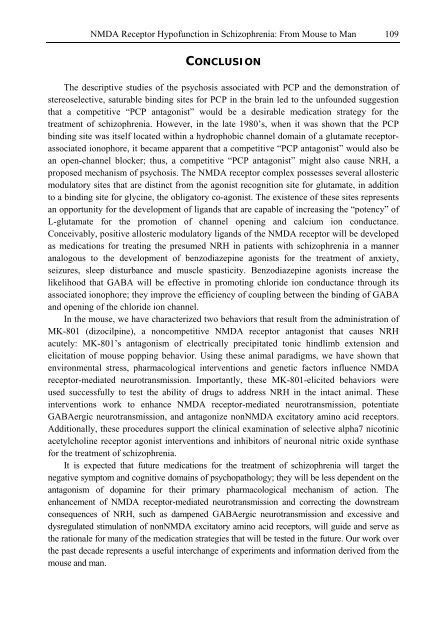Schizophrenia Research Trends
Schizophrenia Research Trends
Schizophrenia Research Trends
- No tags were found...
Create successful ePaper yourself
Turn your PDF publications into a flip-book with our unique Google optimized e-Paper software.
NMDA Receptor Hypofunction in <strong>Schizophrenia</strong>: From Mouse to Man 109CONCLUSIONThe descriptive studies of the psychosis associated with PCP and the demonstration ofstereoselective, saturable binding sites for PCP in the brain led to the unfounded suggestionthat a competitive “PCP antagonist” would be a desirable medication strategy for thetreatment of schizophrenia. However, in the late 1980’s, when it was shown that the PCPbinding site was itself located within a hydrophobic channel domain of a glutamate receptorassociatedionophore, it became apparent that a competitive “PCP antagonist” would also bean open-channel blocker; thus, a competitive “PCP antagonist” might also cause NRH, aproposed mechanism of psychosis. The NMDA receptor complex possesses several allostericmodulatory sites that are distinct from the agonist recognition site for glutamate, in additionto a binding site for glycine, the obligatory co-agonist. The existence of these sites representsan opportunity for the development of ligands that are capable of increasing the “potency” ofL-glutamate for the promotion of channel opening and calcium ion conductance.Conceivably, positive allosteric modulatory ligands of the NMDA receptor will be developedas medications for treating the presumed NRH in patients with schizophrenia in a manneranalogous to the development of benzodiazepine agonists for the treatment of anxiety,seizures, sleep disturbance and muscle spasticity. Benzodiazepine agonists increase thelikelihood that GABA will be effective in promoting chloride ion conductance through itsassociated ionophore; they improve the efficiency of coupling between the binding of GABAand opening of the chloride ion channel.In the mouse, we have characterized two behaviors that result from the administration ofMK-801 (dizocilpine), a noncompetitive NMDA receptor antagonist that causes NRHacutely: MK-801’s antagonism of electrically precipitated tonic hindlimb extension andelicitation of mouse popping behavior. Using these animal paradigms, we have shown thatenvironmental stress, pharmacological interventions and genetic factors influence NMDAreceptor-mediated neurotransmission. Importantly, these MK-801-elicited behaviors wereused successfully to test the ability of drugs to address NRH in the intact animal. Theseinterventions work to enhance NMDA receptor-mediated neurotransmission, potentiateGABAergic neurotransmission, and antagonize nonNMDA excitatory amino acid receptors.Additionally, these procedures support the clinical examination of selective alpha7 nicotinicacetylcholine receptor agonist interventions and inhibitors of neuronal nitric oxide synthasefor the treatment of schizophrenia.It is expected that future medications for the treatment of schizophrenia will target thenegative symptom and cognitive domains of psychopathology; they will be less dependent on theantagonism of dopamine for their primary pharmacological mechanism of action. Theenhancement of NMDA receptor-mediated neurotransmission and correcting the downstreamconsequences of NRH, such as dampened GABAergic neurotransmission and excessive anddysregulated stimulation of nonNMDA excitatory amino acid receptors, will guide and serve asthe rationale for many of the medication strategies that will be tested in the future. Our work overthe past decade represents a useful interchange of experiments and information derived from themouse and man.
















